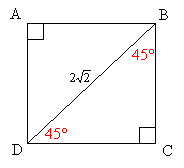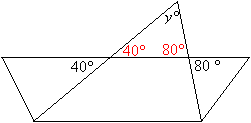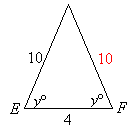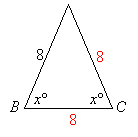SAT Practice Questions - Geometry
For more New Redesigned SAT materials, please see:
New SAT Prep
SAT Math
SAT Geometry
In addition to the questions in Heart of Algebra, Problem Solving and Data Analysis and Passport to Advanced Math, the SAT Math Test will have questions from the areas of geometry, trigonometry and complex numbers.
The following videos and solutions will show you how to solve a variety of Geometry problems for the New Redesigned SAT.
Geometry
These are some of the areas in Geometry that you will need to know for the SAT Math Test.
Lines and Angles: Lengths and midpoints, Vertical angles, Straight angles and the sum of angles about a point, Properties of parallel lines and angles formed by a transversal, Properties of perpendicular lines.
Triangles and other polygons: Right triangles, Pythagorean Triples and the Pythagorean Theorem, Properties of equilateral and isosceles triangles, Properties of 30°-60°-90° triangles and 45°-45°-90° triangles, Congruent triangles and other congruent figures, Similar triangles and other similar figures, The triangle inequality, Quadrilaterals, Regular polygons.
Circles: Radius, diameter and circumference, Measure of central angles and inscribed angles, Arc Length and area of sectors, Tangents and chords.
Solids: Area, Surface Area and Volume
Geometry Practice Test Questions And Step By Step Solutions For The New Redesigned SAT
- Angles, Arc Lengths
- Angles, Arc Lengths
- Right Triangle
- Right Triangle
- Congruence, Similarity
- Congruence, Similarity
- Congruence, Similarity
- Circles
- Circle Theorems
- Circle Theorems
- Area of Triangle
- Area
- Volume
- Volume
- Volume
- Volume
The subsequent materials relate to the SAT before March 2016.
Try out the following Geometry Questions to help you prepare for the SAT, ACT or other similar examinations.
SAT Practice Questions - Geometry:
(Note: You may need to enable JavaScript on your browser for the hints and solutions to show properly.)
Related Pages
More Geometry Lessons
Question 1
What is the area of the following square, if the length of BD is ![]() ?
?
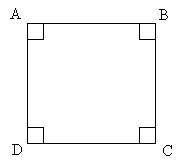
(A) |
1 |
Question 2
In the figure below, what is the value of y ?
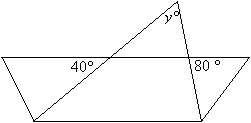
(A) |
40 |
Question 3
Two circles both of radii 6 have exactly one point in common. If A is a point on one circle and B is a point on the other circle, what is the maximum possible length for the line segment AB?
(A) |
12 |
Question 4
A right circular cylinder has a radius of 3 and a height of 5. Which of the following dimensions of a rectangular solid will have a volume closest to the cylinder.
(A) |
4, 5, 5 |
Question 5
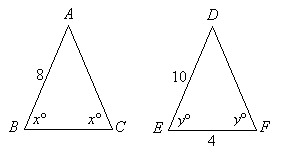
Note: Figures not drawn to scale
In the figures above, x = 60. How much more is the perimeter of triangle ABC compared with the triangle DEF.
(A) |
0 |
SAT Practice Questions - Geometry:
SAT Geometry Problem
This is an SAT style Geometry problem that requires good thinking to solve it. It goes beyond knowing the mathematical formulas.
In the figure below, arc SBT is one quarter of a circle with center R and radius 7. The length plus the width of the rectangle ABCR is 9.5. Find the perimeter of the shaded region.
GMAT Math Problem 03 (Geometry- Angles)
Geometry challenge problem from past GMAT exam.
SAT Math Practice Question - Shaded Area Geometry
What is f(2) for the graph of f(x) below?
SAT Math Practice Question - Geometry with Equilateral Triangle
In the figure WXYT is a square and triangle TYZ is equilateral. If WXYT has area 1, what is the area of triangle TYZ?
Hint: The angles in an equilateral triangle are 60°.
In the following diagram, AD is parallel to BC, AC = 13, BC = 5, BD = 15. What is the length of AD?
SAT Math Practice Question- Coordinate Geometry and Recognizing Triangles
In the figure line OB is rotated counterclockwise, keeping point O fixed. What will be the coordinates of point B when it meets the y-axis?
This video explains how to solve SAT math angle problems. Angle basics discussed include straight angles, vertical angles, angles formed when a line crosses two parallel lines, and the sum of angles in triangles and other polygons. This video contains examples from the official SAT practice tests.
Try the free Mathway calculator and
problem solver below to practice various math topics. Try the given examples, or type in your own
problem and check your answer with the step-by-step explanations.
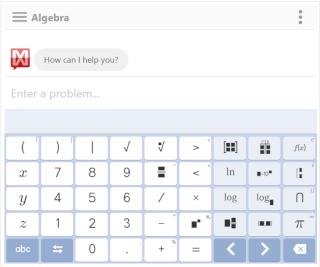
We welcome your feedback, comments and questions about this site or page. Please submit your feedback or enquiries via our Feedback page.
